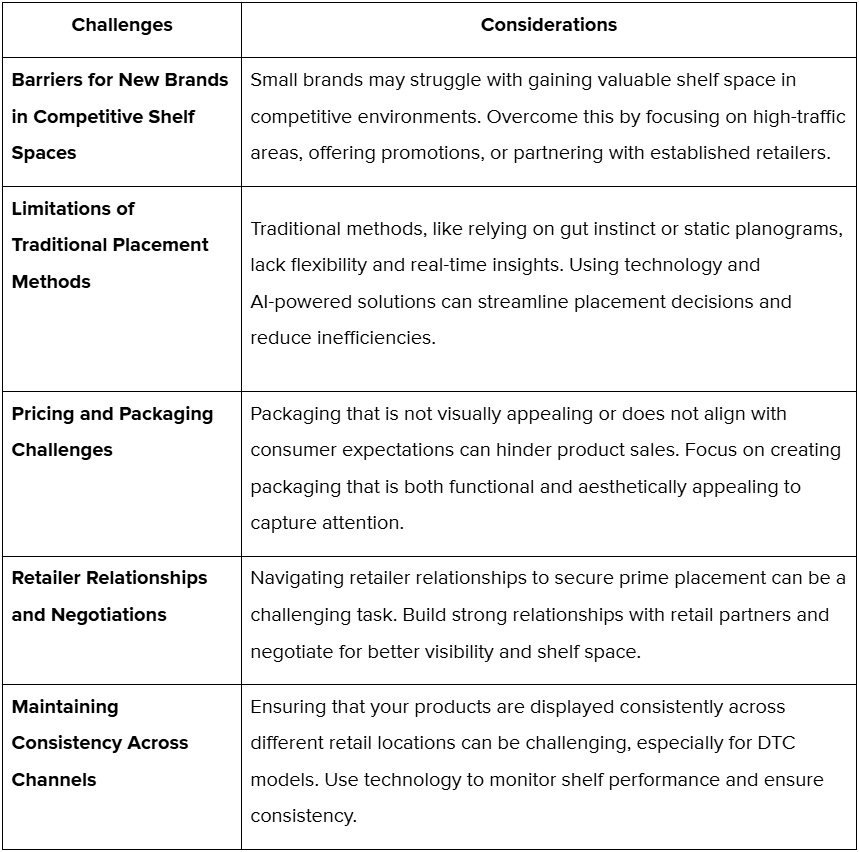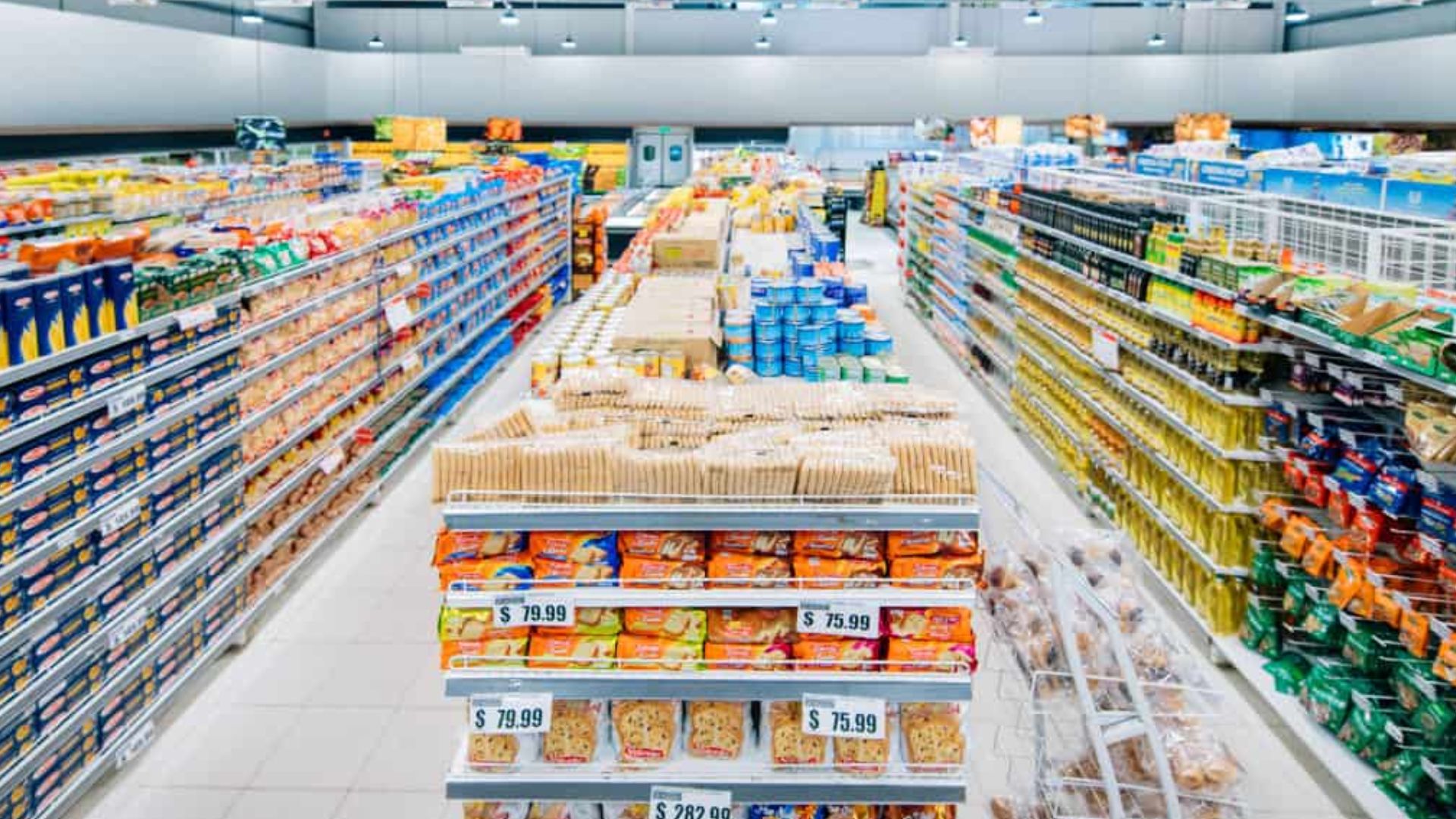According to Ehrenberg-Bass' study, the average consumer spends just 13 seconds making a purchase decision in-store, often relying on habit or instinct (such as a previous purchase). With nearly 70% of purchase decisions made in-store, and 56% of those decisions driven by product placement, the visibility of your product directly correlates with whether or not it gets picked up off the shelf.
With fierce competition in the CPG sector, it’s more crucial than ever to ensure your products are strategically placed in high-visibility areas. However, many brands face challenges in maximizing their on-shelf presence and optimizing placement strategies to capture consumer attention. Manual audits, limited visibility into real-time stock levels, and crowded competitor spaces often hinder brands from effectively managing their product placement. These challenges make it difficult to ensure optimal positioning and availability at all times.
In this article, we will explore the importance of effective product placement for CPG brands, key placement strategies, and the essential elements to optimize in-store execution. Additionally, we’ll address the challenges brands face and provide actionable insights on how to ensure your products stand out and drive consumer engagement.
Key Takeaways
- Effective Product Placement: Strategic positioning, such as eye-level placement and endcaps, can significantly boost consumer purchases.
- Optimizing Visibility with Data and AI: Data-driven insights and AI technologies enhance on-shelf visibility for CPG brands.
- Ensuring Planogram Compliance: Real-time shelf monitoring and automated image recognition ensure products are placed according to planograms, maximizing shelf space.
- Gaining a Competitive Edge: Overcoming challenges in competitive shelf spaces and optimizing placement strategies with technology gives CPG startups a crucial competitive advantage.
How Does Product Placement Impact CPGs?
Product placement plays a pivotal role in influencing consumer purchase behavior. Ensuring your products are strategically positioned on the shelf can drive higher engagement and ultimately lead to increased sales. Here are the key reasons why placement matters:
1. Role of Visibility in Maximizing Sales: Products placed in high-visibility locations, such as endcaps or in-store displays, experience up to a 93% increase in exposure. With 62% of grocery store purchases being unplanned, endcaps play a primary role in driving impulse buys. Strategic product placement in these key areas can significantly boost sales, making visibility essential for maximizing revenue.
2. Impact on Brand Success and Consumer Behavior: Proper placement enhances brand recognition and increases consumer confidence in purchasing your product. When customers consistently see your product in prime locations, they are more likely to develop brand loyalty.
3. Building Consumer Trust: Consistent visibility across multiple locations strengthens consumer trust, as it signals the brand’s reliability. Being easily accessible builds credibility, which is vital for customer retention.
Also Read: Predictions on the Future of Retail Shopping Key Trends and Landscape
What are the Key Placement Strategies for CPG Brands?
When it comes to optimizing product placement, strategic decisions can make all the difference. Below are the most effective placement strategies for CPG brands:
1. Eye-Level Positioning and Its Effects: Eye-level placement is the most valuable shelf real estate, accounting for a significant portion of impromptu sales. Placing your products at eye level ensures maximum exposure and increases the likelihood of being purchased.
2. Utilization of Endcaps and Promotional Displays: Endcaps are prime real estate in stores, with data showing that products placed on endcap displays can move up to eight times faster than those in other store locations. These highly visible areas drive sales and are ideal for promoting new products, limited-time offers, or seasonal items. A well-designed endcap display can significantly capture shoppers' attention, making it crucial to use these spaces effectively.
3. Cross-Category Promotion and Complementary Pairings: Positioning your product next to complementary items (e.g., pairing a snack with a drink) increases the likelihood of cross-selling. By understanding purchasing patterns, CPG brands can effectively position their products to encourage more purchases.
4. Optimizing Product Placement Through Data Analytics: Using data-driven insights allows brands to analyze consumer behavior, predict demand, and place products in the most effective locations. This data ensures placement decisions are based on actual consumer patterns rather than assumptions.
5. Using Digital and In-Store Integration: Combining physical product placement with digital marketing (e.g., using QR codes or in-store digital screens) creates a seamless shopping experience that engages consumers both online and in-store, driving conversions.
Also Read: Strategies for Retail Product Placement in Stores
What are the Key Elements to Successful Product Placement?
Achieving success in product placement requires a deep understanding of consumer behavior, the use of technology, and attention to visual merchandising. Here are the essential elements for optimizing your placement strategy:
1. Understanding Consumer Behavior and Preferences
Consumer behavior is the foundation of a successful product placement strategy. By analyzing shopper demographics, purchasing patterns, and in-store behaviors, CPG brands can make informed decisions on where to place products for optimal visibility and appeal. For example, certain products might perform better in high-traffic areas, while others may benefit from being placed near complementary items or in eye-level positions.
Additionally, understanding preferences for specific categories—whether customers are more likely to purchase organic, sustainable, or health-focused products—can inform placement decisions.
Data-backed consumer insights, such as those gathered from sales reports, shopper surveys, and observational studies, help pinpoint these high-demand zones and enable better decision-making.
As consumer expectations evolve, it’s crucial to remain agile in your approach, ensuring that products are always visible to the most relevant and receptive shoppers.
2. Implementing Technology for Optimized Placement
AI-powered shelf monitoring tools, like ParallelDots' ShelfWatch, provide invaluable insights that enable brands to track placement compliance in real-time. Machine learning algorithms can analyze historical sales data and consumer behavior patterns to identify the most effective product placement strategies.
This predictive capability allows brands to position products in high-traffic areas or locations that align with consumer preferences. ParallelDots' real-time data ensures that products are always optimally placed, stocked, and available, improving in-store performance and enhancing product visibility.
Also read: Recover Lost Sales By Optimizing Retail Execution With Image Recognition
3. Visual Merchandising Techniques to Enhance Placement
Once a product is strategically placed on the shelf, how it’s presented visually plays a pivotal role in driving consumer engagement and conversion. Visual merchandising is about more than just arranging products; it’s about creating an experience that captures attention and entices the shopper to make a purchase.
Key elements of visual merchandising include attractive packaging, clear signage, and well-organized displays. The use of color, lighting, and fonts can also make a significant difference in how products are perceived. For example, vibrant, eye-catching colors can draw attention to a product, while minimalistic design can evoke a sense of sophistication.
The layout of products is just as important. Grouping complementary items or creating thematic displays can encourage impulse buys. Ultimately, the goal is to create an aesthetically pleasing shelf setup that highlights the product’s features and encourages consumers to take notice of it.
A well-executed visual merchandising strategy not only enhances the customer experience but also helps the product stand out from competitors, driving sales and brand recognition.
Also Read: Understanding the Role of Brand and Product Adjacencies in Retail Execution Strategy
4. Agility in Shelf Positioning
The consumer market is constantly changing, and so are consumer preferences. Therefore, a successful product placement strategy must be flexible and responsive to changing market conditions. Continuous monitoring of in-store performance and real-time consumer feedback allows brands to adjust their placement strategies quickly.
Technology plays an important role here by providing instant access to data on product movement, stock levels, and customer interactions. This real-time data enables brands to identify underperforming shelf locations and reallocate stock to high-demand areas. For example, if a particular product is not moving well in one section, you might consider repositioning it to a more prominent spot or introducing a promotion to boost visibility.
Flexibility in shelf positioning ensures that your products remain relevant and accessible to your target audience, improving on-shelf availability and driving sales.
Also Read: Boosting Store Sales by Improving On-Shelf Visibility - A Complete Guide
Challenges and Considerations in Placement Strategies
Optimizing product placement comes with its own set of challenges. Below are some considerations to keep in mind when refining your placement strategies:

How Can ParallelDots Help CPG Brands with Product Placement Optimization?
ParallelDots offers powerful AI-driven solutions to help CPG brands optimize their in-store product placement and ensure on-shelf visibility. By applying deep learning algorithms, real-time shelf monitoring, and predictive analytics, ParallelDots empowers brands to enhance their retail execution and improve the overall customer experience.
Key Features of ParallelDots for Product Placement:
- Real-Time Shelf Monitoring: Track the availability, placement, and stock levels of your products in real-time across various retail locations. This ensures your products are optimally placed in high-traffic areas, preventing out-of-stock situations.
- Automated Image Recognition with ODIN: ParallelDots combines deep learning algorithms with the ShelfWatch app’s On-Device Image Recognition (ODIN) to provide accurate SKU-level product recognition and real-time insights. This allows field reps to monitor product placement, ensure compliance with planograms, and make instant adjustments during in-store visits, even offline, maximizing shelf space and visibility.
- Planogram Compliance Monitoring: Ensure your products are positioned according to predefined planograms to optimize shelf space and increase on-shelf visibility. Our automated solutions make sure that your product placement aligns with the brand's standards and retailer guidelines.
- Pricing Compliance Verification: Using Optical Character Recognition (OCR) technology, ParallelDots verifies that price tags are displayed correctly and comply with retailer standards, preventing pricing errors that could impact sales.
Also read: Retail Optimization and Management through AI-Based Shelf Scanning
Conclusion
Optimizing your product placement strategy is key to enhancing visibility and supporting sales growth. By utilizing advanced technologies like ParallelDots, CPG brands can improve retail execution consistency and ensure better on-shelf availability, helping products remain strategically positioned for maximum impact. This approach can enhance brand presence and drive stronger in-store performance over time.
ParallelDots’ ShelfWatch helps you achieve consistent shelf execution, improve on-shelf inventory, and enhance your brand’s visibility across various retail environments.
Schedule a demo with ParallelDots today to take your product placement strategy to the next level!
FAQs
1. How does product placement impact CPG brands?
Product placement plays a crucial role in influencing consumer behavior and driving sales. Strategically positioning products in high-visibility areas such as eye-level shelves and endcaps increases exposure, boosts consumer confidence, and enhances the likelihood of impulse buys, significantly impacting brand success.
2. What are the best strategies for optimizing product placement?
Key strategies include eye-level positioning, utilizing endcaps and promotional displays, cross-category promotion, and using data analytics to understand consumer behavior and predict trends. Implementing a combination of these tactics maximizes on-shelf visibility and enhances sales potential.
3. How can AI help improve product placement for CPG brands?
AI-driven tools, such as real-time shelf monitoring and predictive analytics, allow CPG brands to optimize product placement by analyzing consumer behavior, predicting demand, and ensuring products are placed in high-traffic areas at the right time. These technologies also help monitor compliance with planograms and avoid stockouts.
4. What challenges do CPG brands face in optimizing product placement?
Common challenges include securing valuable shelf space in competitive environments, dealing with fragmented data, and maintaining consistency across different retail locations. Additionally, packaging that doesn't appeal to consumers or align with their expectations can hinder product sales.
5. How can ParallelDots assist with product placement optimization?
ParallelDots provides AI-powered tools like real-time shelf monitoring, automated image recognition, and planogram compliance checking, enabling CPG brands to track product availability, ensure optimal shelf placement, and enhance in-store visibility, thus improving overall retail execution and customer engagement.


